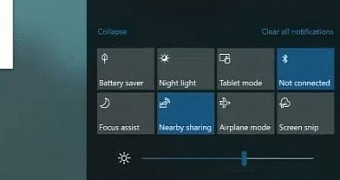The most recent Windows Insider preview build comes with several improvements and new features, but at the same time, it also brings back one of the most requested Windows tools.
The brightness slider officially makes its return in Windows 10 build 18277, technically making it possible for users to adjust the screen brightness to a custom level straight from the Action Center.
Unsurprisingly, this has been one highly popular feature request in Windows 10, especially because the current Microsoft implementation is flawed, to say the least.
A brightness slider was previously available in Windows 8.1, but for some reason, Microsoft pulled it when it officially launched Windows 10.
Instead of a slider, the company offered pre-defined brightness levels which could be changed from a dedicated quick action in the Action Center. The supported levels were 0%, 25%, 50%, and 100%, so in case someone wanted to set the brightness level to 70%, that wasn’t possible from the Action Center.
Coming in 19H1 to everyone
The upcoming Windows 10 19H1 update will bring this slider to all devices, allowing users to pick a custom brightness setting on their tablets and laptops.
Of course, this feature isn’t available on PCs, and it’ll only be enabled on devices with support for custom brightness settings.
Windows 10 19H1 is projected to be finalized in the spring of 2019, and according to Microsoft’s typical release schedule, the RTM build should be signed-off in March. The public rollout could kick off a month later for product devices across the world.
Further improvements and refinements could be released in the coming preview builds, though the simple return of the brightness slider is definitely good news for Windows 10 users. We’ll see how this feature evolves in the next few months, but for now, Microsoft is just proving everyone once again that it’s listening to feedback.

 14 DAY TRIAL //
14 DAY TRIAL //